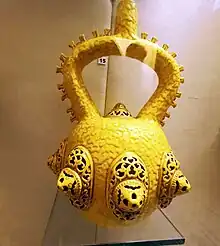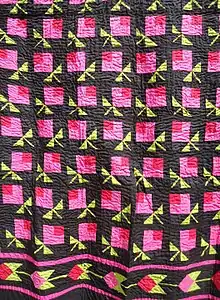The crafts of Sindh and its craftsmen are held in high esteem and their works are notable not only in Sindh but also in many other places.[1][2][3][4][5]
Pottery
The history of pottery in the Sindh region originates from Indus Civilization. The pottery is breathtakingly beautiful. Vessels are painted with the colours of the rainbow and then glazed with earth called "channioh" which imparted lustre and brightness to the finished products. These vessels are used for both decorative and cooking purposes. In old days the utensils, pots etc. were made from pottery.

Blue Pottery:
Kashi tiles: The production of kashi tiles is very old in Sindh, these tiles are famous from Hala and Nasarpur.[6]
Weaving
Lungi: made of silk, cotton and wool, in both bright and soft colours with beautifully woven broad borders of silver and gold thread.[7] The use of bright, bold and vibrant colors with gold zari on the Lungi make its worth and significance.
Sussi: Sussi is a term for multicolored striped or checked cloth produced mainly in Hala, Hyderabad and Thatta, Sindh.[8][9] Sussi is thin handloom fabric made of cotton, silk, or a blend of the two, with colored warp stripes. Sindh region was known for its production and exports during the Mughal period. Sussi was most often made with red and blue, blue and white, or green and white stripes, but other patterns were also produced. The fabric was exported to England, where sousaes were in great demand in the 18th century.[10] Sussi is used for women trousers or for Skirt.
Khes: traditional rug
Khatho: traditional shawls.
Kaleen/Gilim/Galicho: Sindhi carpets made in tharparker.
Block printing
Ajrak: a traditional block printed shawl of Sindh, ajrak displays many special designs and patterns made using wooden stamps, and dyed with both vegetable dyes and mineral dyes, madder and indigo are important.

Maleer: is block printed shawl used by women, nowadays so many designs of maleer are used as dress.
Quilts
Ralli: a traditional quilts of Sindh. The tradition of ralli/rilli making is very old in Sindh. The word ralli is derived from the sindhi word "ralanna", which means (to mix and connect). The ralli is made by placing many layers of cloth, one upon the other. The lowest layer is called "tah" mostly of bright and dark colors, with either applique or patchwork on top layer making amazing geometrical designs, patterns, motifs and objects on top layer. The layers are sewn together by simple running stitch called "kunh".

Rallis are usually used as lightweight coverlet, it can also be used as a prayer mat (musallo), floor covering, or used as a cover for things. Almost every house in Sindh have collection of rallis, usually made by the women of house for everyday use. The rallis are also given as dowry to daughters, the small piece of ralli for babies is called "rilko". In Sindh, two different types of ralli are made, the applique (tuk) ralli and the patchwork ralli.

Ghadelo: The traditional mattress used for sitting and sleeping.
Sawarh: Traditional blanket used in the cold season.
Tie and dye
Bandhni or bandhno is traditionally used for making skirts and long veils. Lar (Delta region) and thar desert region of Sindh are famous for Bandhni making.
Embroidery and mirrorwork
Sindh is well known for its embroideries and mirrorwork. There are various stitches and embroideries throughout Sindh.
Gaj: A solid embroidery over the woman's shirt it usually covers the area, starting from neck up to the stomach. It incorporates variety of stitches and colors. Sometimes, it is made on separate piece of cloth and then attached to the garment.
Woodcarving
Woodcarving is done in Shikarpur, many intricate designs are made on wood for doors, beds, etc.[11]
Lacquer work
Lacquer work, or jhandri jo kam is one of the most beautiful arts on wood. Almost all the material for Sindhi craftsmen came from the River Indus. The wood from the trees on its bank was used for carvings and furniture beautifully decorated with lacquer work. The object was coated with a fine powder and polished. Traditional designs were outlined with paint and filled with bright and beautiful colours. After they dried they were varnished with shellac. A swing called pingho, sofas, chairs, vases, utensils and lamps are some of the famous items made in jhandri.[1]
Basketry
There are so many villages in Sindh which have many artisans, who use local things to make handicrafts. Khairpur and Sukkur districts are renowned for its date palm gardens. Apart from producing different date products, many locals make use of leaves and branches of palm trees to make numerous basketry products, the women of these districts, use date leaves, branches of plants, wheat husk, dried grains, and other materials to make amazing handicrafts.[12]

Many items are made like Chabiyu/Pindiyu (plate for bread roti), hotpots, mats, hand fans etc., these items are also decorated with colorful pompoms, metallic thread and sometimes with mirrors.
Leatherwork
Artisans manufactured many fine things in leather in earlier centuries. Coverlets, hangings, bed and table covers and ornamental shields and bucklers. The finest camel coverings called "Nuhs" and horse trappings in leather worked with silver thread were highly esteemed for their workmanship.[13][14]
Shoes: Sindhi jutti and Sindhi khusso and Mojri are traditionally made from leather with various embroideries, beads etc. on them. Sindhi mochis were famous for making these shoes.
Other crafts
- Bamboo work: Bamboo sticks are used for making furniture, traditional curtains, and wall hanging with mirrors and decorations. Also Bamboo homes and local restaurants are made.[15] In rural sindh a traditional chair called "moorho" and table are made from chusquea culeou bamboo, put together with reeds and straw.[16]
- Beadwork: Beadwork (Motin jo kam) is used in many things, like jewelry, Sagi/Choti, keychains, pens, Agath, for decorations on busses and rickshaws.[17][18]
- Jewelry: Silver, gold, copper and ivory/plastic and glass jewelry is used in Sindh, The glass bangles of Hyderabad and plastic bangles of thar is also famous. Other traditional sindhi jewelries are: (for Neck: Duhri, Haar, Nimbori, Hassi), (for Ears: Wala/Dur, Waliyon, Jhumak, Leelum, Dawriyon), (for arms: Chooriyon, Banhi, Kara, Kari, Kangar, Chura, Magali/Magili, Banhrakhi, bazuband), (for Fingers: Mundri, Chalo), (forehead/head: Tiko, Chindi, Paso, Bakal, Taj Tikko, Kilpri, Kaanta, Bindi), (for Nose: Nath, Nathri, Phuli, Booli, Boolo), (Ankles/feet: Payal, Pazaib, Jhanjhar, Chehr, Katiyoon, Pairan ju mundrio, Pairan ja kara), (Hands: Chambo, Hath), (Waist: Chehlkee), other: Magar, Baiser, Bainno, Bandra, Tawiz, Tikilin, Pasi, Paunchi, Jhamar, Aali, Kewtyoon, Kundho, Munhan Danni, Vidhi etc.[19]
- Applique work: tuk jo kam is done on clothes and on other stuff.
- Camel barber art: camel hair on their body is cut to make amazing patterns on camel's skin. This art of camel hair cut is done mostly in desert region of Sindh, sometimes black color and henna is also used to make different designs.[20][21]
- Copper bells: metal bells are made for cattle and other animals; these are used all over Sindh for their animals.
- Ivory work/Shell work: In past Ivory carved jewelry for women and ivory carved wooden furniture and other ivory products were quite common in Sindh, ancient port city bhambhore had worlds largest ivory workshop discovered in the world,[22] also in Hyderabad and Karachi seashell products are still made.[23][24] This ancient ivory work has been almost died, but seashell and plastic bangles resembling of ivory are still made in lower part of Sindh.
.jpg.webp) Sindh, circa 1650-1670
Sindh, circa 1650-1670.jpg.webp) Cabinet on stand (Contador) Sindh, 16th-17th century, ebony, shisham, ivory and brass fittings, National Museum of Ancient Art, Lisbon.
Cabinet on stand (Contador) Sindh, 16th-17th century, ebony, shisham, ivory and brass fittings, National Museum of Ancient Art, Lisbon. - Sindhi Khat: the khat or charpai is a traditional woven bed of India and Pakistan, but sindhi khats have their own uniqueness, these are made of different styles, patterns, designs and material. The small khat is called "manjhi".[25]
- Sindhi Traditional Doll: Sindhi doll called guddi/guddo(f/m) is traditional way of making dolls from white cloth sewn in human shape, and stuffed with cotton or small pieces of cloth, these were made to be played by kids.[26][27] now a jute made dolls are also made.
- Sindhi Sagi/Choti: sagi/choti is an hair accessory used by sindhi women and Punjabi women as well to tie their hairs into braids, it is made of many colors, beads, pompons, shells, mirrors etc., traditionally some sindhi women also used a silver or gold metal jewelry on hair braids as well.[28]
See also
References
- 1 2 Reejhsinghani, Aroona (2004). Essential Sindhi Cookbook. Penguin Books India. ISBN 978-0-14-303201-4.
- ↑ Arshad, Rabia (2022-02-14). "Pottery and Other Handicrafts of Sindh". HouseofPakistan. Retrieved 2023-05-27.
- ↑ Mughal, Dr Shahid (2015-06-23). "Sindh Handicrafts". InfoMazza.com. Retrieved 2023-05-27.
- ↑ Harris, Jennifer (2020-09-16). A Companion to Textile Culture. John Wiley & Sons. ISBN 978-1-118-76890-7.
- ↑ Duarte, Adrian (1982). The Crafts and Textiles of Sind and Baluchistan. Institute of Sindhology, University of Sind.
- ↑ "Clay Culture: Blue Kashi Tiles". Default. Retrieved 2023-06-09.
- ↑ "The living textile traditions of Sindh. - Free Online Library". www.thefreelibrary.com. Retrieved 2023-05-27.
- ↑ Bunting, Ethel-Jane W. (1980). Sindhi Tombs and Textiles: The Persistence of Pattern. Maxwell Museum of Anthropology : University of New Mexico Press. ISBN 978-0-8263-0540-4.
- ↑ Bullo, Momin (2011). Matiari: The Cultural Capital of Sindh. District Government, Matiari.
- ↑ Montgomery, Florence M. (1984). Textiles in America 1650-1870 : a dictionary based on original documents, prints and paintings, commercial records, American merchants' papers, shopkeepers' advertisements, and pattern books with original swatches of cloth. Internet Archive. New York ; London : Norton. ISBN 978-0-393-01703-8.
- ↑ "Sindh Crafts | Heritage Foundation of Pakistan". www.heritagefoundationpak.org. Retrieved 2023-05-29.
- ↑ "Basketry — from remote villages to urban market". The News International. 2016-12-24. Retrieved 2023-05-29.
- ↑ Qazi, Waheeda Khizir (2010). Handicrafts of Sindh. Culture Department, Government of Sindh.
- ↑ Bombay. 1874.
- ↑ "Pakistani architect's bamboo homes rebuilding lives and livelihoods for flood survivors". gulfnews.com. 2022-10-15. Retrieved 2023-06-07.
- ↑ Agha, Nadia (2017-01-03). "The children who make these colourful chairs in Khairpur have a story to tell". DAWN.COM. Retrieved 2023-06-07.
- ↑ Hasan, Shazia (2018-10-21). "Zainab Market's a favourite among foreigners for its Sindhi handicrafts". Images. Retrieved 2023-05-28.
- ↑ "Sindhi Artisan Handicrafts: Beaded Casings For Bottle And Mortar And Pestle Set Stock Image - Image of mortar, handmade: 117288823". www.dreamstime.com. Retrieved 2023-05-28.
- ↑ Gazetteer of the Province of Sind ... government at the "Mercantile" steam Press. 1907.
- ↑ Hamdani, Anas (2018-08-22). "Eid makeover: The art of camel barbering". DAWN.COM. Retrieved 2023-05-28.
- ↑ "Pakistani barbers decorate camels with ancient motifs in elaborate Eid makeover". Arab News PK. 2021-07-22. Retrieved 2023-05-28.
- ↑ "Archaeologists discover huge ivory factory in Pakistan's ancient Bhanbhore city". Arab News PK. 2020-02-20. Retrieved 2023-06-07.
- ↑ "RBSI - Shells, shell bangles and ivory from excavations. Brahmanabad and Depar Gangro, Hyderabad District. - 1896 Photograph of miscellaneous shells, shell bangles and ivory from excavations at Brahmanabad". rarebooksocietyofindia.org. Retrieved 2023-06-07.
- ↑ haaretzcom (2020-03-05). "Biggest Ivory Workshop in Ancient World Discovered in Pakistan". South Asia Journal. Retrieved 2023-06-07.
- ↑ Desk, Dekho (2023-05-12). "US Company Is Selling Sindhi 'Charpai' For Over Rs 3.5 Lakh". Dekho. Retrieved 2023-06-09.
- ↑ "21 Traditional Sindhi dolls I made ideas | traditional, dolls, made". Pinterest. Retrieved 2023-06-11.
- ↑ Hath Ki Bani Hui Sindhi Cultural Dolls 😍 #Shorts, retrieved 2023-06-11
- ↑ "Tribal Sindhi Long Paranda Hair Catcher". Wholesale Kuchi Jewels. Retrieved 2023-06-11.